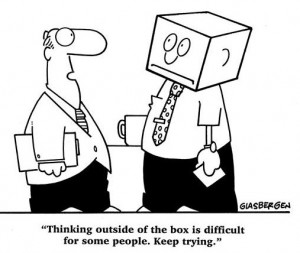Peripheral vision
 The world is changing so rapidly these days that we are constantly confronted with both new dilemmas and new opportunities. And often when confronted with these new puzzles we rely on the same skills and tactics which got us to where we are today. But what if solving 21st century problems and building 21st century opportunities requires new thinking? Here’s a few problem solving ideas for when your team feels stymied
The world is changing so rapidly these days that we are constantly confronted with both new dilemmas and new opportunities. And often when confronted with these new puzzles we rely on the same skills and tactics which got us to where we are today. But what if solving 21st century problems and building 21st century opportunities requires new thinking? Here’s a few problem solving ideas for when your team feels stymied
- Restate the puzzle. In as many ways as you can, rephrase the problem using different words and perspectives. The best way to do this effectively is to take turns around the table and have different players try this exercise. You are certain to uncover new clues to the solution as well as isolate what really matters. To often we get hung up on aspects that don’t merit as much mindshare as we allow initially. By using different vantage points on a particular problem, you get closer to the essence of the issue and recognition of the real value you are trying to generate. Because again, any puzzle – a technical fix, a service issue, a product enhancement – is ultimately aimed at value generation
- Approach from downwind. In other words, attack the problem so it doesn’t see you coming. Come at the puzzle from a direction it never suspects. Chances are you have confronted something similar in the past and you follow the well-trod neurons in your brain. This tactic can be expedient in a pinch but unlikely to to produce something novel. If the challenge is both prickly and you have the luxury of a bit of time, try a new approach
- Call in the talent. Reach out to your network and don’t be afraid to ask for help. Your posse internally and outside your organization are pleased to be tapped and eager to reveal their ingenuity. You are likely to find a new elegant fix from a source you already know.
Or finally try this – instead of thinking outside the box, find the right box to think in. That’s right, innovation by analogy. Borrow brilliance.


